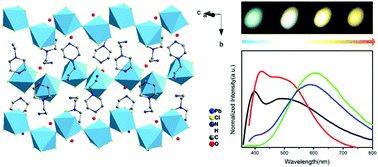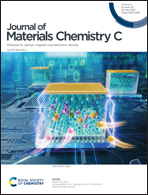A one-dimensional dual emissive hybrid perovskite with flexibly tunable white-light emission†
Abstract
White-light emissive hybrid perovskites have received continuous attention because of their potential applications in solid-state lighting and displays. However, there have been limited reports about dual-emissive white-light hybrid perovskites, although they enable a wide range of emission switching. Here, we report a one-dimensional hybrid perovskite, (N-AEP)2Pb2Cl10·H2O (NAPC, N-AEP = 1-piperazineethylammonium), which exhibits dual-emissive photoluminescence with a wide emission switch ranging from blue to orange. Significantly, tunable white-light emission from “cold” white light (0.25, 0.29) to “warm” white light (0.40, 0.42) can be easily observed by finely tuning the excitation wavelength. Under excitation at 335 nm, a “cold” white light with chromaticity coordinates (0.31, 0.33) close to those of “optimal” white light (0.33, 0.33) is achieved. Furthermore, NAPC exhibits a color rendering index reaching 93.4, which is among the highest values currently reported from white-light emissive hybrid perovskites. This work paves a way to tune the photophysical properties of hybrid perovskites, and highlights their potential for solid-state lighting applications.



 Please wait while we load your content...
Please wait while we load your content...